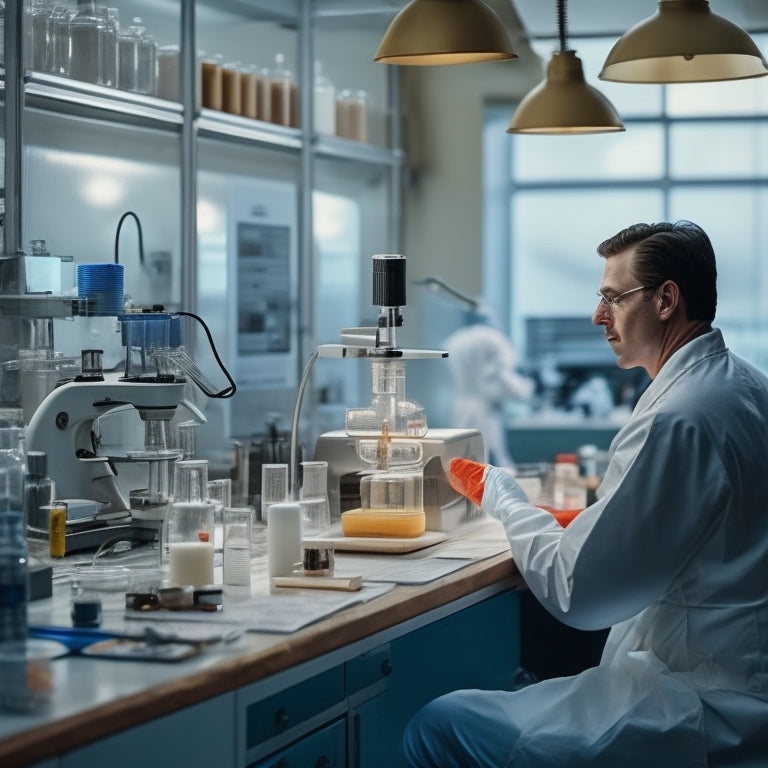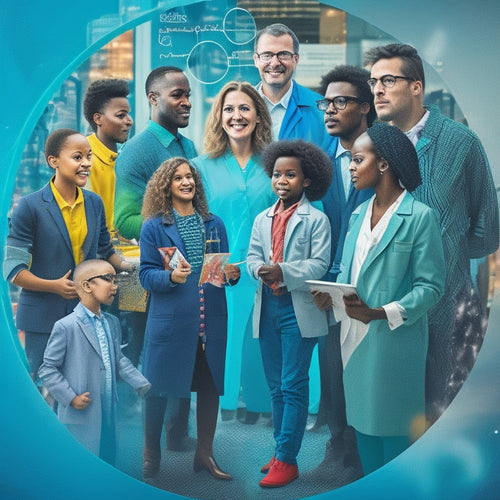
Laboratory Best Practices: Ensuring Experiment Credibility
Share
Laboratory best practices are essential for ensuring the credibility of experimental results. Pre-experiment preparation, including cleaning protocols and Good Laboratory Practice (GLP) compliance, sets the stage for reliable data. Accurate measurement techniques, such as meniscus reading and pipetting precision, and solution preparation and handling protocols, like proper storage and labeling, also play critical roles. Effective liquid separation methods, including gravity filtration and centrifugation, are essential for preventing contamination and ensuring safety. By following these best practices, researchers can generate high-quality, reproducible data that maintains the integrity of their research findings, and uncover the nuances of experimental design and execution.
Key Takeaways
• Adherence to Good Laboratory Practice (GLP) guidelines ensures the reliability and international acceptance of research data.
• Implementing quality control measures and regular checks maintains the credibility of research and prevents data contamination.
• Accurate measurement techniques, such as meniscus reading and pipetting precision, are critical for reproducible results and reliable data.
• Proper solution preparation, storage, and handling protocols prevent contamination, ensure solution integrity, and guarantee reliable results.
• Effective liquid separation methods, including gravity filtration, vacuum filtration, and centrifugation, are essential for preventing contamination and ensuring safety.
Pre-Experiment Preparation Essentials
Three essential aspects of pre-experiment preparation - cleaning, adhering to Good Laboratory Practice (GLP), and precise measurement techniques - form the foundation of a successful laboratory experiment.
Cleaning protocols are critical in preventing contamination and maintaining lab safety standards, guaranteeing the accuracy of results.
GLP compliance is mandatory for organizations conducting studies, as it ensures the quality and integrity of non-clinical laboratory studies. By following GLP guidelines, researchers can secure the reliability of test data and international acceptance.
Additionally, precise measurement techniques are essential in laboratory experiments, as they directly impact the accuracy of results.
Ensuring Data Integrity and Quality
Accurate and reliable data is the hallmark of a successful laboratory experiment. Guaranteeing data integrity and quality is a critical step in maintaining the credibility of research findings.
To achieve this, laboratories must implement robust quality control measures that cover all aspects of data collection, recording, and analysis. This includes validating data against established standards, conducting regular quality control checks, and documenting all experimental procedures and results.
Accurate Measurement Techniques
In laboratory settings, accurate measurement techniques are essential for generating reliable data, as even minor discrepancies can greatly impact the validity and reproducibility of experimental results. To guarantee accurate measurements, laboratory professionals must master techniques such as meniscus reading and pipetting precision. These skills require attention to detail, a steady hand, and a thorough understanding of laboratory equipment.
| Measurement Technique | Description | Importance |
|---|---|---|
| Meniscus Reading | Reading the curved surface of a liquid in a cylinder | Confirms accurate volume measurement |
| Pipetting Precision | Transferring precise volumes of liquids | Critical for reproducible results |
| Titration | Adding a titrant to a solution until a reaction occurs | Enables accurate quantification of analytes |
| Volumetric Measurements | Measuring volumes of liquids using calibrated equipment | Essential for chemical reactions and analyses |
| Micropipetting | Transferring small volumes of liquids with high precision | Vital for molecular biology and genetics research |
Solution Preparation and Handling
Precision in solution preparation and handling is paramount to guaranteeing the validity and reliability of experimental results. Even minor discrepancies in concentration or composition can greatly impact the outcome of a study. To maintain the integrity of solutions, it is essential to follow proper preparation and handling protocols.
Proper solution storage is crucial. Store solutions in a cool, dry place, away from direct sunlight and moisture. Careful chemical handling is necessary to prevent contamination, spills, or exposure to incompatible materials. Labeling and dating solutions accurately is also important to ensure tracking and accountability.
Effective Liquid Separation Methods
Separation of liquids or solutions is a pivotal step in various laboratory procedures, demanding careful consideration of the most suitable method to achieve efficient and effective separation of components.
Gravity filtration, a traditional method, separates solutions through a filter, but can be time-consuming. Vacuum filtration, on the other hand, aids in faster separation of liquids by applying a vacuum pressure. Centrifugation techniques separate components based on density, allowing for precise separation of particles.
By selecting the right method, laboratory professionals can guarantee accurate results, prevent contamination, and maintain laboratory safety standards.
Effective liquid separation methods are essential in ensuring the credibility of experimental results, making them an integral aspect of laboratory best practices.
Frequently Asked Questions
What Are the Consequences of Not Following Laboratory Safety Protocols?
What's the cost of a careless mistake in the lab? Failure to follow safety protocols can lead to legal liability, reputation damage, and even harm to personnel, making a culture of safety a non-negotiable imperative.
How Do I Handle and Store Hazardous Chemicals and Waste?
When handling hazardous chemicals and waste, prioritize Chemical Segregation by categorizing and storing substances by reactivity and compatibility, and maintain meticulous Waste Tracking records to guarantee responsible disposal and minimize environmental impact.
Can I Reuse Laboratory Equipment Without Cleaning and Sanitizing?
Reusing laboratory equipment without proper cleaning and sanitizing compromises Equipment Reliability, risking Cross Contamination and inaccurate results, which can have devastating consequences in scientific research and experimentation, making cleanliness a non-negotiable priority.
What Is the Procedure for Reporting Laboratory Accidents and Incidents?
'In the world of lab mishaps, where beakers shatter and pipettes weep, a heroes' guide to reporting accidents awaits! Conduct an Accident Analysis, followed by an Incident Review, to guarantee transparency and accountability in the pursuit of scientific truth.'
How Often Should Laboratory Equipment Be Calibrated and Maintained?
To prevent Equipment Downtime, establish Calibration Schedules for laboratory equipment, ensuring timely maintenance and minimizing instrument failure, thereby guaranteeing accurate results and upholding the integrity of experimental data.
Related Posts
-

Community Engagement: Learning Through Professions
Community engagement is a powerful tool for fostering a deeper understanding of various professions among children. B...
